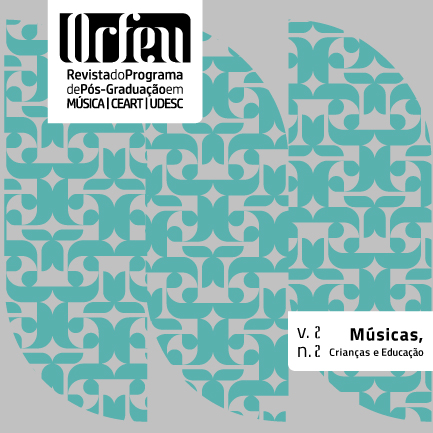Musicalidade comunicativa e senso de eu
DOI :
https://doi.org/10.5965/2525530402022017133Mots-clés :
Musicalidade comunicativa, Senso de eu, Processos intersubjetivosRésumé
Este artigo apresenta um estudo teórico sobre o conceito de musicalidade comunicativa proposto por Malloch (1999), Malloch e Trevarthen (2009), e o de senso de eu, conforme defende Daniel Stern (1992-2000), com o objetivo de aprofundar a compreensão sobre a natureza das relações que o ser humano estabelece com a música. A estratégia consiste em estabelecer um diálogo com alguns pesquisadores, articulando suas ideias na compreensão do tema proposto. Conclui-se que as relações intersubjetivas são o ponto comum que articula os dois conceitos. Na musicalidade comunicativa, elas são responsáveis pela estrutura emocional que garante a experiência musical compartilhada; na formação do senso de eu e sua contrapartida, eu com o outro criam possibilidades de aprendizagem, dentre elas, a possibilidade de um senso de eu musical ou uma possibilidade de identidade musical.
Téléchargements
Références
BARRETT, Margaret. Attending to “culture in the small”: A narrative analysis of the role of play, thought and music in young children’s world-making. Research Studies in Music Education, v. 38, n. 1, p. 41-54, 2016.
BEEBE, B.; ALSON, D.; JAFFE, J.; FELDSTEIN, S.; CROWN, C. Vocal Congruence in Mother-Infant Play. Journal of Psycholinguistic Research, v. 17, n. 3, p. 245-259, 1988.
DISSANAYAKE, Ellen. Ethology, interpersonal neurobiology, and play. Insights into the evolutionary origin of the arts. American Journal of Play, v.9, n. 2, p.143-168, 2017.
______. Antecedents of the temporal arts in early mother-infant interaction. In: NILS, L. Wallim; MERKER, Björn; BROWN, Steven (Eds.). The Origins of Music. Cambridge, MA: MIT Press, 2001. p. 389-410.
______. The earliest narratives were musical. Research Studies in Music Education, v. 34, n. 1, p. 3-14, 2012.
FERNALD, Anne; SIMON, Thomas. Expanded intonation contours in mothers' speech to newborns. Developmental Psychology, v. 20, n. 1, p. 104-113, 1984.
FERNALD, Anne. Four-month-old infants prefer to listen to “motherese”. Infant Behavior Development, v. 8, p. 181-195, 1985.
HARGREAVES, D. J.; MACDONALD, R.; MIELL, D. Musical identities mediate musical development. In: MCPHERSON, G & WELCH, G. (Eds.). Oxford Handbook of Music Education. V. 1. Oxford: Oxford University Press, 2012. p. 125-142.
IMBERTY, Michel. Narrative, splintered temporalities and the unconscious in 20th century music. Musicae Scientiae, Special Issue, p. 129-146, 2008.
KIRSCHNER, S.; TOMASELLO, M. Joint music making promotes prosocial behavior in 4-year-old children. Evolution and Human Behavior, v. 31, p. 354-364, 2010.
MALLOCH, S.; TREVARTHEN, C. (Eds.). Communicative musicality: Exploring the basis of human companionship. Oxford, UK: Oxford University Press, 2009.
MALLOCH, S. Mothers and infants and communicative musicality. Musicae Scientiae, Special Issue, p. 29-57, 1999-2000.
MAFFIOLETTI, L. A. Aprendizagens sociais propiciadas pela música na infância. In: SANTIAGO, D.; BROOCK, A.; CARVALHO, T. (Orgs.). Educação Musical Infantil. Salvador: PPGMUS-UFBA, 2011. p. 60-73.
MAFFIOLETTI, Leda de A. A música e as primeiras aprendizagens da criança. In: FLORES, Maria Luiza Rodrigues e ALBUQUERQUE, Simone (Orgs.). A implementação do PROINFÂNCIA no Rio Grande do Sul. Perspectivas politicas e pedagógicas. Porto Alegre: EdiPUCRS, 2014. p. 119-126. Disponível em: <http://ebooks.pucrs.br/edipucrs/Ebooks/Pdf/978-85-397-0663-1.pdf>.
PAPAUŠEK, Hanuš. Musicality in infancy research: Biological and cultural origins of early musicality. In: DELIÈGE, I.; SLOBODA, J. (Eds). Musical Beginnings. Origins and development of musical competence. 2. ed. Oxford: Oxford University Press, 2000. p. 37-55.
STERN, Daniel. Diário de um bebê. O que seu filho vê, sente e vivencia. Tradução Daise Batista. Porto Alegre: Artes Médicas, 1991.
STERN, Daniel. Forms of Vitality. Exploring dynamic experience in psychology, the arts, psychotherapy, and development. Oxford: Oxford University Press, 2010.
STERN, Daniel. O momento presente na psicoterapia e na vida cotidiana. Tradução Celimar de Oliveira Lima. Rio de Janeiro: Record, 2007.
STERN, Daniel. Putting time back into our considerations of infant experience: a microdiachronic view. Infant mental health journal, v. 21, n. 1-2, p. 21-28, 2000.
STERN, Daniel. O mundo interpessoal do bebê. Uma visão a partir da psicanálise e da psicologia do desenvolvimento. Tradução Maria Adriana Veríssimo Veronese. Porto Alegre: Artmed, 1992.
STILL face experiment. Dr. Edward Tronick. Vídeo. Duração: 2’49”.
Infant-Parent Mental Health Program. ZERO TO THREE.
Disponível em: <https://www.youtube.com/watch?v=apzXGEbZht0&t=9s>.
Acesso em: 23 set. 2017.
TREVARTHEN, C.; DELAFIELD-BUTT, J. T. Intersubjectivity in the imagination and feelings of the infant: Implications for education in the early years. In: WHITE, Jaine; DALLI, Carmen (Eds.). Under-three year olds in policy and practice. New York: Springer, 2017. p. 17-40.
TREVARTHEN, C.; AITKEN, K. Infant Intersubjetivity, research theory, and clinical application. Journal of child psychology and psychiatry, v. 42, n. 1, p. 3-48, 2001.
Téléchargements
Publiée
Comment citer
Numéro
Rubrique
Licence
(c) Tous droits réservés ORFEU 2017

Ce travail est disponible sous la licence Creative Commons Attribution 4.0 International .






